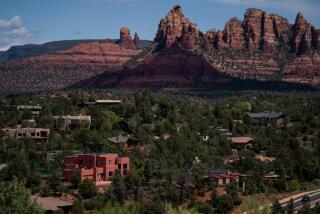Suburban Sprawl Threatens Untamed Charm of Historic Arizona Town
- Share via
PRESCOTT, Ariz. — Prescott was a nameless meadow surrounded by pine-studded hills when it became the Arizona territorial capital more than a century ago.
There were no residents to speak of. Even a nearby fort was little more than a group of circled wagons in the wilderness.
Now there is debate over whether the 135-year-old town can retain the untamed feel and small-town charm that have been cornerstones of its history.
The focal point of the downtown area remains a historic courthouse with a columned facade overlooking a grassy square. The town still has tree-lined streets with clapboard-sided Victorian houses, a rarity in the Southwest.
But the look changes on the town’s outskirts, where the chain stores are proliferating. Rolling hills have been carved up to make room for strip malls and parking lots. They will soon be joined by a regional mall, another magnet for controversy.
Yavapai County Supervisor Gheral Brownlow said a lot of the traditional ranchers and cowboys who once defined the area’s character are leaving the fast-growing town, which ballooned from 4,200 residents in 1950 to 35,000 today.
Still, Brownlow and other residents say that things would be worse had the state capital not been relocated.
“Prescott had open space, and we still have a lot of that. Within 15 minutes, I could take you out to a remote area from anyplace in downtown,” he said.
Melissa Ruffner, a descendant of one of the area’s first families, said that losing the capital has kept the town out of the mainstream. “The growth would have come much sooner,” she said. “The fact that we were sort of out of the mainstream has preserved us.”
That Prescott was ever named the territorial capital had more to do with Confederate sympathies in Tucson than anything else, said Ruffner and Norm Tessman, the senior curator at the Sharlot Hall Museum in Prescott.
Tucson was a more logical location for the capital, Ruffner said. It had people, for one thing. But it also had Confederate soldiers, and residents willing to pledge loyalty to anybody who could protect them from the chaos that overtook the city during the Civil War, Tessman said.
So when President Lincoln declared Arizona a territory on Feb. 24, 1863, he sent a group of territorial officials to Prescott to set up a capital.
When they arrived Dec. 28, 1863, Ruffner said, the meadow where the city would be founded had little more than a creek, some prospectors and newfound gold.
The capital was established in the unnamed town by territorial Gov. John Goodwin. It got its name in a popularity contest of sorts, Tessman said: The first territorial secretary, who later became the territorial governor, liked the writings of William Hickling Prescott who had never visited the area and who died years before the town was founded.
The capital was moved to Tucson in 1867, dealing a near-fatal blow to the economy of Prescott, Ruffner said.
For the next decade, the mining continued, ranchers moved in and Ft. Whipple brought in military men. Prescott became capital again in 1877, but after 12 years of controversy, the capital was moved to Phoenix, a small agricultural community that was home to the state’s insane asylum.
“It was an ego-deflating thing” for Prescott, Ruffner said. “Initially they were very upset, but overall it was a good thing. It kept us a smaller community.”
More to Read
Sign up for Essential California
The most important California stories and recommendations in your inbox every morning.
You may occasionally receive promotional content from the Los Angeles Times.













